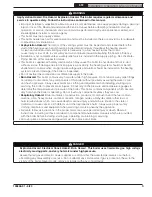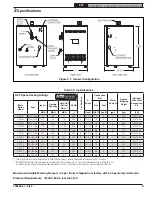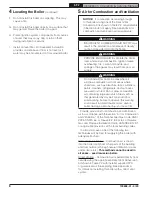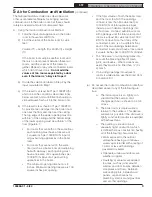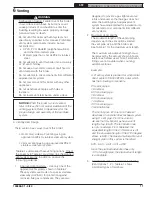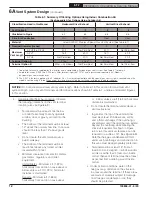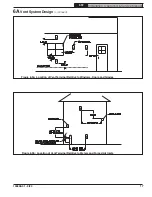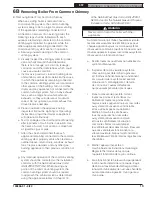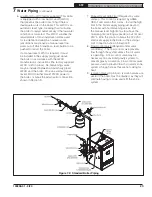
9
109838-01 - 5/20
X-PV
Installation, Operating & Service Manual
The
National Fuel Gas Code
does describe some
other acceptable techniques for bringing outdoor
combustion air to the boiler room, but these should
rarely be needed and are not discussed here.
A. Using the Indoor Combustion Air Method
1) Total the input of all appliances in the boiler
room in thousands of BTU/hr.
2) Find the volume of the boiler room in cubic
feet:
Volume (ft
3
) = Length (ft) x Width (ft) x Height
(ft)
If the boiler room adjoins another room and
there is no door present between these two
rooms, add the volumes of the rooms to-
gether. Repeat for any other connected rooms
which do not have doors.
Do not add the
volume of two rooms separated by a door
even if that door is “always left open”.
3) Divide the volume obtained in Step 2 by the
input calculated in Step 1.
4) If the result is at least 50 ft
3
per 1000BTU/hr,
and none of the conditions described in (6)
below are met, normal infiltration should pro-
vide adequate fresh air into the boiler room.
5) If the result is less than 50 ft
3
per 1000BTU/
hr, provide two openings into the boiler room,
one near the floor and one near the ceiling.
The top edge of the upper opening must be
within 6” of the ceiling and the bottom edge
of the lower opening must be within 6” of the
floor (Figure 5.1):
• For rooms that are both on the same floor,
each opening must have a free area of
1 square inch per 1000 BTU/hr input of
all gas burning appliances in the boiler
room.
• For rooms that are not all on the same
floor (such as a boiler room and adjoining
hall with stairway), each opening must
have a free area of 2 square inches per
1000 BTU/hr input of all gas burning
appliances in the boiler.
• The minimum opening dimension is 3
inches. Minimum opening free area is 100
square inches per opening.
• If the total volume of both the boiler room
and the room to which the openings
connect is less than 50 cubic feet per
1000 BTU/hr of total appliance input,
install a pair of identical openings into
a third room. Connect additional rooms
with openings until the total volume of all
rooms is at least 50 cubic feet per 1000
BTU/hr of input. Note that if any of the
connected rooms, is on a different floor,
each of the two openings between all
connected rooms must have a free area of
2 square inches per 1000 BTU/hr of input.
• The “free area” of an opening takes into
account the blocking effect of mesh,
grills, and louvers. Where screens are
used, they must be no finer than ¼” (4 x
4) mesh.
• If providing openings into adjacent
rooms is undesirable, use the Direct Vent
Conversion Kit.
6) Do not use the Indoor Combustion Air Method
described above if any of the following are
true:
a. The indoor space is so tightly con-
structed that the number of air
changes per hour is known to be 0.4
or less.
b. The boiler room is depressurized
relative to the outdoors. This depres-
surization is possible if the structure is
tightly constructed and/or is equipped
with exhaust fans.
c. The building is known to be of
unusually tight construction, which
is defined here as construction having
all of the following characteristics:
• Walls exposed to the outdoor
atmosphere having a continuous
water vapor retarder with a rating of
1 perm or less with openings
gasketed or sealed.
• Openable windows and doors are
weather stripped.
• Caulking or sealants are applied
to areas, such as joints around
window and door frames, between
sole plates and floors, between
wall-ceiling joints, between wall
panels, at penetrations for
plumbing, electrical and gas lines
and at other openings.
5
Air for Combustion and Ventilation
(continued)



